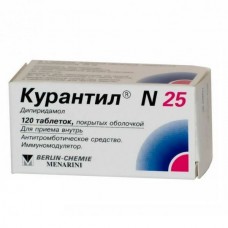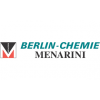Expiration date: 10/2026
The composition and form of issue:
Curantyl N 25
Tablets, film-coated 1 tab.
dipyridamole 25 mg
excipients: lactose monohydrate cornstarch gelatin, carboxymethyl starch sodium salt (type A) silicon dioxide, highly dispersed magnesium stearate
the composition of the shell: hypromellose talc macrogol 6000 titanium dioxide quinoline yellow dye (dye E104) simethicone emulsion
in glass vials of 120 PCs in a box 1 vial.
Curantyl N 75
Tablets, film-coated 1 tab.
dipyridamole 75 mg
excipients: lactose monohydrate cornstarch gelatin, carboxymethyl starch sodium salt (type A) silicon dioxide, highly dispersed magnesium stearate
the composition of the shell: hypromellose talc macrogol 6000 titanium dioxide quinoline yellow dye (dye E104) simethicone emulsion
blistere in 20 PCs in a carton 2 blisters.
Description pharmaceutical form:
Pills: yellow to greenish-yellow, with smooth surfaces have a uniform appearance.
The coated tablets: valium, yellow.
Feature:
A derivative of pyrimidine.
Pharmacological action:
Competitive ingibiruet adenozindezaminazy, contributing to the accumulation of adenosine, involved in the regulation of coronary blood flow, and the ability of platelets to aggregation and adhesion. Does fosfodiesterzu and increases the content of camp in cells. As a derivative of pyrimidine, Chimes is the inducer of interferon and has a modulating effect on the functional activity of interferon enhances nespecificescuu antiviral resistance to viral infections.
Pharmacokinetics:
Rapidly absorbed from the stomach (the majority) and small intestine (small numbers). Almost entirely associated with plasma proteins. Cmax within 1 h after administration. Accumulates primarily in the heart and erythrocytes. Metabolized by the liver by binding with glucuronic acid, excreted in the bile in the form of monoglucuronide. For tablets T1/2 is 10 h ± 2,2 h
Description pharmacological action:
Lowers the resistance of coronary arteries at the level of small branches and arterioles, increases the number of collaterals and collateral blood flow improves concentration adenosine and ATP synthesis in miocarde improves his airway, reduces round, lowers AD, inhibits platelet aggregation (improves microcirculation, prevents arterial thrombosis), normalizes venous outflow, reduces resistance brain receptacles corrigiruet placental blood flow in the risk of pre-eclampsia warns dystrophic changes in the placenta, eliminates tissue hypoxia fruit contributes to the accumulation of glycogen provides modulation effect on the functional activity of interferon enhances nespecificescuu antiviral resistance to viral infections.
Indications:
Treatment and prevention of disorders of cerebral circulation, discirculatory encephalopathy, prophylaxis of arterial and venous thrombosis and their complications, thromboembolism after surgery, prosthetic heart valves, placental insufficiency with complicated pregnancy, in the complex therapy for any violations of the microcirculation, as an inductor of interferon and immunomodulator for the prevention and treatment of influenza, SARS.
Contraindications:
Hypersensitivity, acute myocardial infarction, unstable angina, stenosing atherosclerosis of the coronary arteries, asthma heart failure, subaortic aortic stenosis, hypotension, and hypertension (severe), collapse, arrhythmia, ulcer of stomach and duodenal ulcers (in the acute phase), liver and/or renal failure, hemorrhagic diathesis, age 12.
Application of pregnancy and breast-feeding:
Perhaps under the supervision of a physician and for indications.
Side effects:
It is rarely possible nausea, vomiting, diarrhea, dizziness, headache, myalgia hypotension, transient flushing of the face, tachycardia, allergic skin reactions.
Drug interactions:
Weaken the effect of xanthine derivatives (e.g. coffee, tea) — increased indirect oral anticoagulants (heparin, thrombolytics) or acetylsalicylic acid (increased risk of hemorrhagic complications). Increases gipotenzivne the antigipertenziveh funds weakens the cholinergic properties of cholinesterase inhibitors. Increases antiaggregatory action of antibiotics-cephalosporins (cefamandole, cefoperazone, cefotetan). Antatsida reduce maximum concentration due to the lower absorption.
Method of application and dose:
Inside, erh, not liquid, squeezed small amount of liquid.
To reduce platelet aggregation: 75-225 mg/day in divided doses, in severe cases, dose increase to 600 mg/day.
For the prevention of influenza and other acute respiratory viral infections, especially during epidemics: 50 mg/day (2 table. or 2 tablets of 25 mg once), 1 time per week for 4-5 weeks.
To prevent relapses, often ill respiratory viral infections patients: 100 mg/day according to the scheme: 50 mg (2 table. or 2 tablets of 25 mg) 2 times a day with an interval of 2 hours, 1 time per week for 8-10 weeks.
Precautions:
Avoid drinking coffee and tea (possibly weakening effect).



